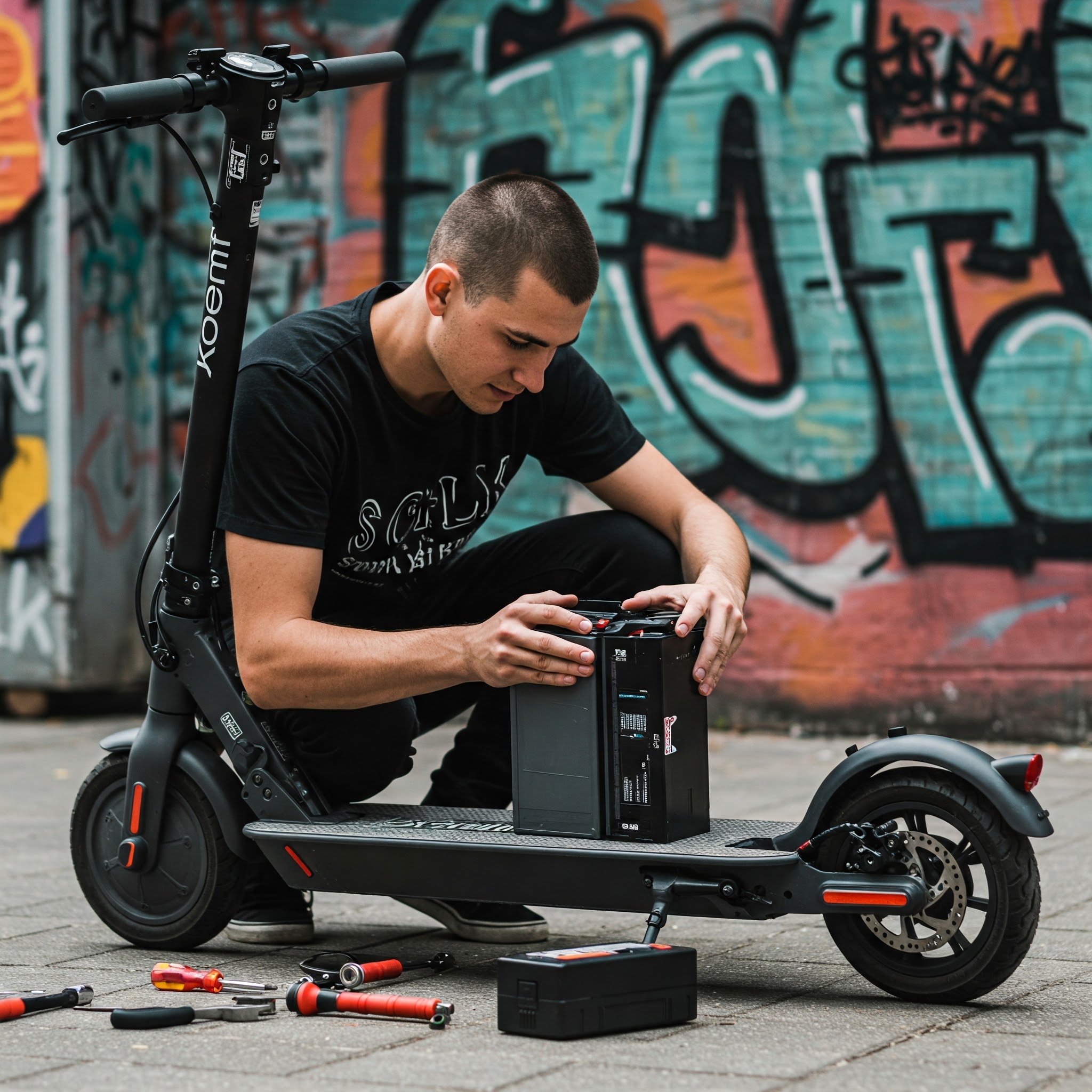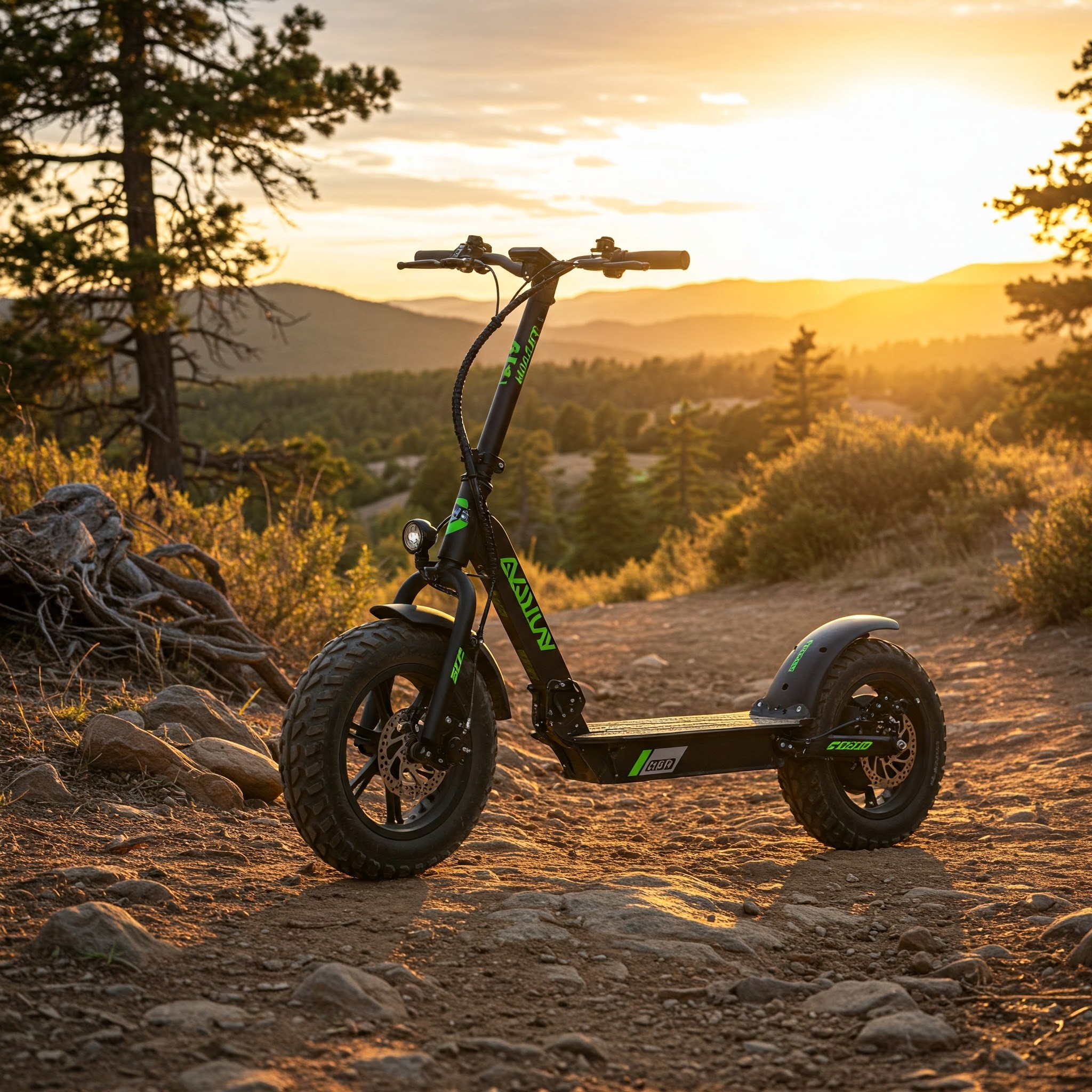Welcome to your comprehensive guide on electric scooter battery technology! If you’ve recently purchased an electric scooter or are considering getting one, understanding the battery that powers your ride is absolutely essential. After all, the battery is literally the heart of your electric scooter, determining how far you can travel, how long you’ll wait for a recharge, and ultimately, how enjoyable your riding experience will be.
As someone who has spent years testing and reviewing electric scooters, I’ve learned that many riders overlook the importance of their electric scooter battery until they encounter problems. However, with the right knowledge and maintenance habits, you can significantly extend your battery’s lifespan and get the most out of your investment.
In this in-depth guide, we’ll explore everything you need to know about electric scooter batteries, from the different types available to crucial maintenance tips and top replacement options on the market. Whether you’re a daily commuter, weekend adventurer, or just curious about the technology, this article will equip you with valuable insights to power your rides for years to come.
⚡ Understanding Electric Scooter Battery Types
When it comes to electric scooter battery technology, not all options are created equal. In fact, the type of battery powering your scooter significantly impacts its performance, lifespan, and overall value. Let’s break down the most common battery types you’ll encounter:
🔋 Lithium-Ion Batteries
Lithium-ion batteries have revolutionized the electric scooter industry and are now the gold standard for most modern models. There are several compelling reasons why manufacturers prefer these batteries:
- ✅ Higher energy density (more power in a smaller, lighter package)
- ✅ Longer lifespan (typically 500-1000 charge cycles)
- ✅ Lower self-discharge rate when not in use
- ✅ No memory effect, meaning you can charge them at any level without degradation
- ❌ More expensive than lead-acid alternatives
- ❌ Require sophisticated battery management systems
Most premium electric scooters today feature lithium-ion batteries, and for good reason. Despite their higher initial cost, their superior performance and longevity make them a worthwhile investment for serious riders.
🔋 Lead-Acid Batteries
Once common in earlier electric scooter models, lead-acid batteries are becoming increasingly rare in new designs. Nevertheless, you might still encounter them in budget-friendly options:
- ✅ Lower upfront cost
- ✅ Well-established recycling infrastructure
- ✅ Reliable and proven technology
- ❌ Heavier and bulkier than lithium-ion alternatives
- ❌ Shorter lifespan (typically 200-300 charge cycles)
- ❌ Require more maintenance and careful charging habits
- ❌ Longer charging times
While lead-acid batteries might save you money initially, their reduced range, heavier weight, and shorter lifespan often make them less economical in the long run. Furthermore, they’re generally not the best choice for portable or lightweight scooters.
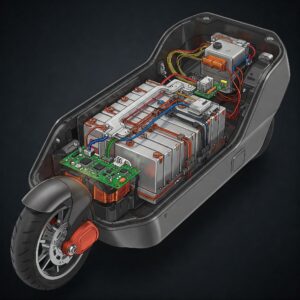
🔋 Lithium Iron Phosphate (LiFePO4) Batteries
A newer contender in the electric scooter battery arena, LiFePO4 batteries offer some compelling advantages:
- ✅ Exceptional safety profile and thermal stability
- ✅ Impressive lifespan (often 2000+ charge cycles)
- ✅ Better performance in extreme temperatures
- ✅ More environmentally friendly composition
- ❌ Lower energy density than standard lithium-ion
- ❌ Premium price point
These batteries are increasingly appearing in high-end electric scooters where safety and longevity are paramount concerns. Although they might not offer the same range as traditional lithium-ion in the same size package, their extended lifespan can make them an excellent choice for daily riders.
🔌 Key Electric Scooter Battery Specifications Explained
Understanding the specifications of your electric scooter battery is crucial for making informed decisions about your purchase and usage. Let’s demystify the key metrics that determine battery performance:
⚡ Voltage (V)
Voltage essentially determines the “pressure” of electricity flowing through your scooter’s system. Higher voltage generally translates to more power and better hill-climbing ability. Most electric scooter batteries operate in these voltage ranges:
- 24V: Typically found in entry-level or children’s scooters
- 36V: Common in commuter-focused models
- 48V: Present in performance-oriented scooters
- 52V-72V: Reserved for high-performance and off-road models
It’s worth noting that voltage directly influences the top speed your scooter can achieve. Consequently, if you’re looking for a faster ride, pay close attention to this specification.
⚡ Capacity (Ah)
Measured in ampere-hours (Ah), capacity indicates how much energy the electric scooter battery can store. Think of this as the size of your “fuel tank.” A higher Ah rating generally means you can travel farther on a single charge.
Most consumer electric scooters feature batteries ranging from 5Ah to 30Ah. To put this in perspective, a typical commuter scooter might have a 10Ah battery, providing approximately 15-20 miles of range under ideal conditions.
⚡ Watt-Hours (Wh)
The most accurate way to compare electric scooter battery capacity across different models is by examining their watt-hour rating. You can calculate this by multiplying voltage by ampere-hours:
Wh = V × Ah
For example, a 36V 10Ah battery offers 360Wh of energy. Meanwhile, a 48V 8Ah battery provides 384Wh. Despite having a lower Ah rating, the 48V battery actually stores more energy!
When manufacturers advertise range, they’re essentially telling you how efficiently their scooter uses the available watt-hours. As a rough guideline, expect 10-15Wh per mile of range in real-world conditions.
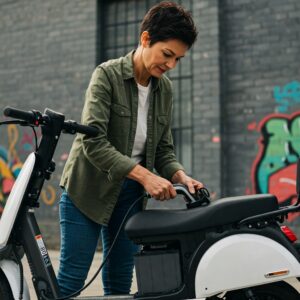
⚡ Charging Time
How long does it take to recharge your electric scooter battery? This depends on two factors:
- Battery capacity (larger batteries take longer to charge)
- Charger output (measured in amps)
Most standard chargers deliver 1.5-2A of current, requiring 4-8 hours for a full charge. However, some scooters support fast charging with 3A or higher chargers, potentially cutting charging time in half.
It’s important to note that faster charging generates more heat and can potentially reduce your battery’s lifespan if used exclusively. For optimal battery health, standard charging is recommended for routine use, with fast charging reserved for occasions when time is limited.
⚡ Cycle Life
A charge cycle occurs when you use 100% of your battery’s capacity, whether in a single ride or across multiple partial charges. The cycle life refers to how many complete charge-discharge cycles your battery can undergo before its capacity diminishes to about 80% of its original value.
Lithium-ion electric scooter batteries typically offer 500-1000 cycles, while LiFePO4 batteries can achieve 2000+ cycles. In practical terms, this means most scooter batteries should last 2-5 years with regular use before requiring replacement.
📊 Top Electric Scooter Battery Products in 2025
Whether you’re looking to replace an aging battery or upgrade your scooter’s performance, these top-rated options deliver exceptional value:
🥇 Replacement Batteries
| Product | Compatibility | Capacity | Weight | Price Range |
|---|---|---|---|---|
| LotFancy 36V 7.8Ah Lithium Battery | Xiaomi M365/Pro, GoTrax | 36V 7.8Ah (280.8Wh) | 2.7 lbs | $$$ |
| Wingsmoto 48V 15Ah Battery Pack | Universal with BMS | 48V 15Ah (720Wh) | 7.5 lbs | $$$$ |
| URBANTRIX 36V 10Ah Replacement Battery | Segway/Ninebot ES series | 36V 10Ah (360Wh) | 3.2 lbs | $$$ |
| ANSENI 36V 8Ah Battery Pack | Multiple models with XT60 connector | 36V 8Ah (288Wh) | 3.0 lbs | $$ |
🔍 Battery Chargers
| Product | Output | Compatibility | Features | Price Range |
|---|---|---|---|---|
| TEEBOL Fast Charger 3.0A | 42V 3.0A | 36V Li-ion Systems | LED indicator, overcharge protection | $$ |
| YUNTONG 54.6V 2A Charger | 54.6V 2A | 48V Li-ion Systems | UL certified, auto-shutoff | $$ |
| KUWAN 42V 2A Dual-Port Charger | 42V 2A (per port) | 36V Li-ion Systems | Charges two batteries simultaneously | $$$ |
🛠️ Battery Accessories
| Product | Purpose | Compatibility | Key Benefit | Price Range |
|---|---|---|---|---|
| POWLAB Battery Voltage Tester | Monitoring | Universal | Real-time voltage display | $ |
| DERECCO Battery Protection Case | Storage/Protection | Universal | Water/impact resistant | $$ |
| VELOGICAL Battery Extension Cable | Installation | Multiple connectors included | Flexible mounting options | $ |
🔆 Power Up Your Ride With These Top-Rated Products! 🔆
Ready to enhance your electric scooter’s performance? Click on any highlighted product above to check current pricing and availability on Amazon. These carefully selected battery solutions will help you maximize range and enjoy longer-lasting rides with peace of mind!

🔋 Maximizing Your Electric Scooter Battery Life
One of the most frequent questions I receive from readers is how to extend their electric scooter battery lifespan. Fortunately, with the right habits, you can significantly prolong your battery’s useful life and get the most value from your investment. Here are my tried-and-tested recommendations:
⚡ Optimal Charging Practices
How you charge your electric scooter battery plays a crucial role in determining its longevity. Follow these guidelines for best results:
- ✅ Avoid complete discharges whenever possible. Lithium-ion batteries prefer partial discharge cycles.
- ✅ Try to maintain your battery level between 20% and 80% for daily use.
- ✅ Use the manufacturer-supplied charger or an approved replacement.
- ✅ Charge in moderate temperatures (60-75°F/15-24°C is ideal).
- ❌ Don’t leave your scooter charging overnight or for extended periods after reaching 100%.
- ❌ Avoid using fast chargers exclusively, as they generate more heat.
For long-term storage, the ideal electric scooter battery charge level is around 50-60%. This balance minimizes stress on the cells while providing enough reserve to prevent over-discharge.
⚡ Temperature Management
Temperature has a profound impact on electric scooter battery performance and longevity. Extreme conditions can significantly reduce your battery’s capacity and accelerate degradation:
- ✅ Store your scooter indoors at room temperature when not in use.
- ✅ Allow your scooter to cool down before charging after riding in hot weather.
- ✅ In cold weather, warm your battery to room temperature before riding for optimal performance.
- ❌ Avoid exposing your scooter to direct sunlight for extended periods.
- ❌ Never charge a frozen battery (bring it to room temperature first).
Many riders notice significantly reduced range in cold weather – this is normal and usually temporary. Your battery isn’t necessarily damaged; the chemical reactions simply occur more slowly at lower temperatures.
⚡ Riding Habits That Preserve Battery Health
Beyond charging practices, how you ride your scooter directly impacts battery consumption and longevity:
- ✅ Accelerate gradually rather than with full throttle.
- ✅ Maintain a consistent speed when possible.
- ✅ Use regenerative braking systems if your scooter has them.
- ✅ Select eco mode for longer rides when you don’t need maximum speed.
- ❌ Avoid unnecessary rapid acceleration and hard braking.
- ❌ Minimize hill climbing when your battery is very low.
Remember that advertised ranges are typically achieved under ideal conditions: lightweight rider, flat terrain, moderate speed, and perfect weather. Real-world range often falls 20-30% below these figures due to hills, wind resistance, and riding style.
⚡ Preventive Maintenance
Regular maintenance can help identify potential issues before they compromise your electric scooter battery:
- ✅ Check connection points regularly for corrosion or loose contacts.
- ✅ Monitor charging time – a significant increase could indicate battery degradation.
- ✅ Keep battery contacts clean with an electronics-safe contact cleaner.
- ✅ Inspect battery housing for damage or swelling (a sign of potential failure).
- ❌ Never attempt to open or repair battery packs yourself.
- ❌ Don’t use your scooter if the battery emits unusual odors or shows deformation.
For riders in humid or coastal environments, battery connections are particularly vulnerable to corrosion. A light application of dielectric grease can help protect these critical connection points.
💡 Troubleshooting Common Electric Scooter Battery Issues
Even with proper care, you might encounter battery-related problems. Here’s how to diagnose and address the most common issues:
🔍 Reduced Range
If you’re experiencing significantly shorter rides than when your scooter was new, consider these potential causes and solutions:
- Cause: Battery degradation over timeSolution: This is normal aging. If your battery has less than 70% of its original capacity after 500+ cycles, replacement may be warranted.
- Cause: Cold weather operationSolution: Temporary reduction is normal. Store your scooter indoors and give the battery time to warm up before riding.
- Cause: Increased rider weight or cargoSolution: Reduced range under higher load is expected. Consider minimizing carried items or upgrading to a higher capacity battery.
- Cause: Underinflated tires (increases rolling resistance)Solution: Maintain proper tire pressure according to manufacturer specifications.
Many riders find that their electric scooter battery range stabilizes after the first 10-20 charge cycles, sometimes even improving slightly as the battery management system calibrates.
🔍 Charging Problems
Issues with charging can be particularly frustrating. Here’s how to address them:
- Symptom: Charger LED doesn’t change from red to greenPotential causes: Battery at maximum capacity already, faulty charger, internal battery damageSolution: Test with another compatible charger if available. If problem persists, consult a repair specialist.
- Symptom: Charger gets extremely hotPotential causes: Faulty charger, improper ventilation, internal short circuitSolution: Disconnect immediately and replace the charger. Ensure charging occurs in a well-ventilated area.
- Symptom: Battery charges very quickly but depletes rapidlyPotential causes: Battery cell damage, BMS failureSolution: Battery replacement is likely necessary.
Always remember that charger issues can sometimes indicate more serious battery problems. If in doubt, consult a professional rather than risking damage to expensive components.

🔍 Performance Issues
Problems with power delivery can manifest in several ways:
- Symptom: Inconsistent power (cutting out during acceleration)Potential causes: Loose connections, BMS protection triggering, voltage sag under loadSolution: Check all electrical connections. If problem persists, a professional diagnosis is recommended.
- Symptom: Significant power reduction without warningPotential causes: Thermal protection activated, BMS limiting output to protect cellsSolution: Allow system to cool down completely. If problem occurs regularly, the battery or controller may need replacement.
- Symptom: No power despite charged batteryPotential causes: BMS shutdown, main fuse blown, controller failureSolution: Check fuses if accessible. Otherwise, professional diagnosis is required.
A multimeter can be an invaluable tool for diagnosing electric scooter battery issues, allowing you to verify the actual voltage at various points in the system. However, never attempt to bypass safety systems or disassemble battery packs.
🌐 The Future of Electric Scooter Battery Technology
The electric scooter industry continues to evolve rapidly, with battery technology at the forefront of innovation. Here’s what we can expect to see in the coming years:
🔮 Solid-State Batteries
Perhaps the most exciting development on the horizon is solid-state battery technology. These next-generation batteries replace the liquid or gel electrolyte found in conventional lithium-ion cells with a solid electrolyte, offering several potential advantages:
- ✅ Higher energy density (potentially 2-3x current batteries)
- ✅ Faster charging capabilities
- ✅ Superior safety with virtually no fire risk
- ✅ Extended cycle life and longevity
- ✅ Better performance in extreme temperatures
While solid-state batteries remain primarily in the research and development phase, several manufacturers have announced plans to bring this technology to consumer products within the next few years. When they arrive, we can expect electric scooters with dramatically improved range and performance.
🔮 Smart Battery Management Systems
Advanced BMS technology is making electric scooter batteries more intelligent and user-friendly:
- ✅ Smartphone integration for real-time battery health monitoring
- ✅ Predictive analytics to forecast remaining range based on riding habits
- ✅ Adaptive charging protocols that adjust based on battery condition
- ✅ Self-diagnosis capabilities to identify potential issues early
These smart systems will help riders maximize their electric scooter battery performance while minimizing the risk of unexpected failures during critical journeys.
🔮 Sustainable and Ethical Battery Production
As environmental awareness grows, manufacturers are increasingly focusing on creating more sustainable battery options:
- ✅ Reduced reliance on rare earth minerals and controversial mining practices
- ✅ Development of batteries with easier recycling pathways
- ✅ Carbon-neutral manufacturing processes
- ✅ Battery second-life programs for grid storage applications
This emphasis on sustainability aligns perfectly with the eco-friendly nature of electric scooters themselves, creating a more holistic approach to green transportation.
⚡ Ready to Upgrade Your Electric Scooter Battery? Don’t Miss These Deals! ⚡
Enhance your riding experience today with our top-recommended battery products. Click on any highlighted product name to check current Amazon pricing and take advantage of special offers before they’re gone!
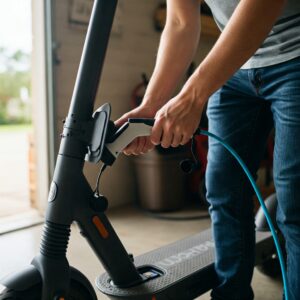
🏁 Conclusion: Powering Your Electric Scooter Journey
Throughout this comprehensive guide, we’ve explored the fascinating world of electric scooter battery technology, from understanding the fundamental types and specifications to troubleshooting common issues and glimpsing future innovations. Having this knowledge empowers you to make informed decisions about your electric scooter and maximize your riding experience.
Remember that your electric scooter battery represents not just a significant portion of your scooter’s value but also the key determinant of its performance and reliability. By following the maintenance practices outlined in this guide, you can potentially double your battery’s useful lifespan and save hundreds of dollars in replacement costs.
Whether you’re shopping for a new electric scooter, seeking to replace an aging battery, or simply looking to better understand the technology beneath your feet, I hope this guide has provided valuable insights. The electric scooter revolution continues to gain momentum, and battery technology advances will only make these eco-friendly transportation options more compelling in the years ahead.
Have you encountered any interesting electric scooter battery challenges or discoveries in your own experience? I’d love to hear about them in the comments below!
More FQAs:
❓ How long does an electric scooter battery last?
✅ Most electric scooter batteries last between 2 to 4 years or 300 to 500 full charge cycles, depending on usage, battery type, and maintenance habits…
❓ Can you replace an electric scooter battery yourself?
✅ Yes, many electric scooter batteries are user-replaceable with basic tools, but always check compatibility and safety instructions before attempting a replacement…
❓ How much does a new electric scooter battery cost?
✅ A replacement electric scooter battery typically costs between $100 to $400, depending on the brand, capacity, and type of battery used…
❓ What’s the best battery type for electric scooters?
✅ Lithium-ion batteries are the most popular for electric scooters due to their long lifespan, lighter weight, and faster charging compared to lead-acid alternatives…
❓ How do you know if your electric scooter battery is bad?
✅ Signs of a failing scooter battery include shorter ride time, slower acceleration, difficulty charging, or the scooter not turning on even after a full charge…
Recommended for You:
- 10 Best Electric Scooter 30mph Options That Will Revolutionize Your Commute
- 7 Best Big Wheel Scooter Options That Will Transform Your Urban Commute
- 10 Best 3 Wheels Scooter Options for All Ages in 2025
Disclaimer: This article contains affiliate links. If you purchase products through these links, we may earn a small commission at no additional cost to you.

